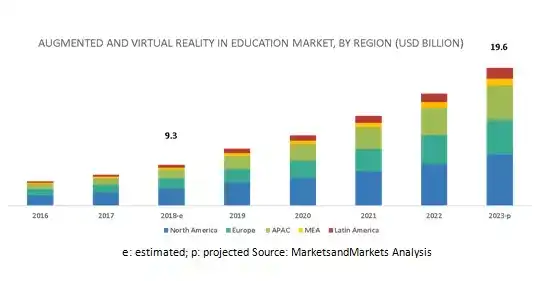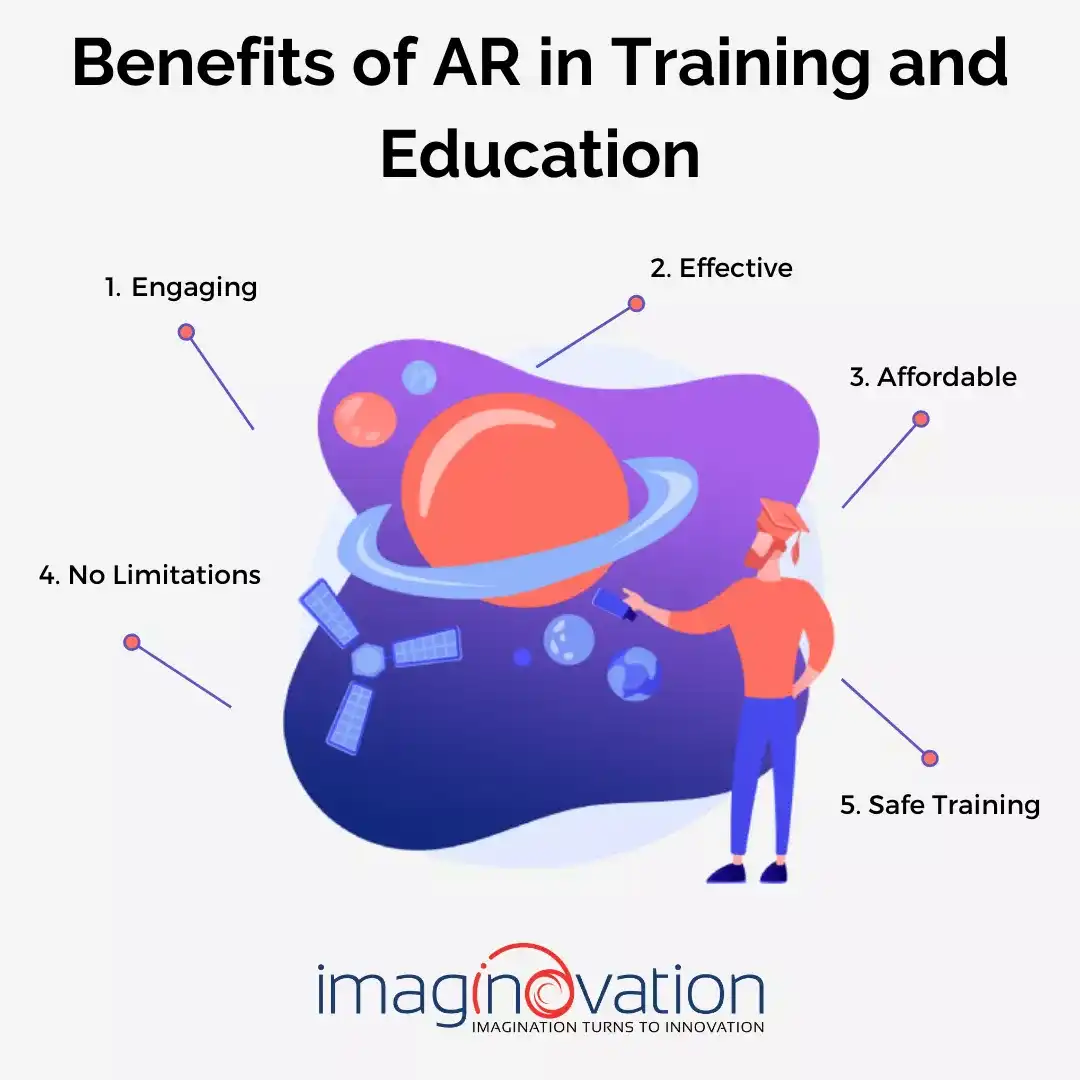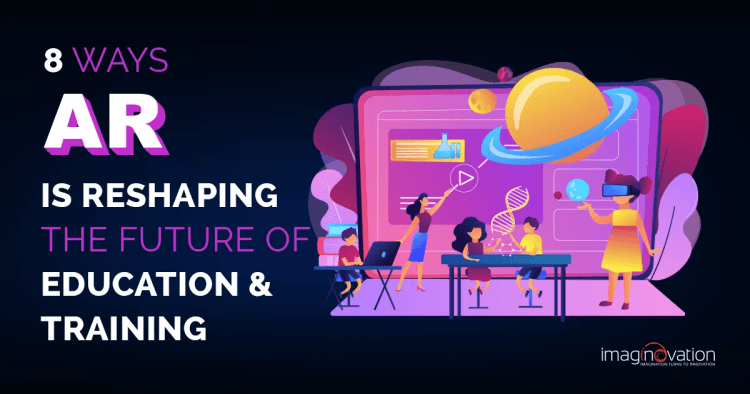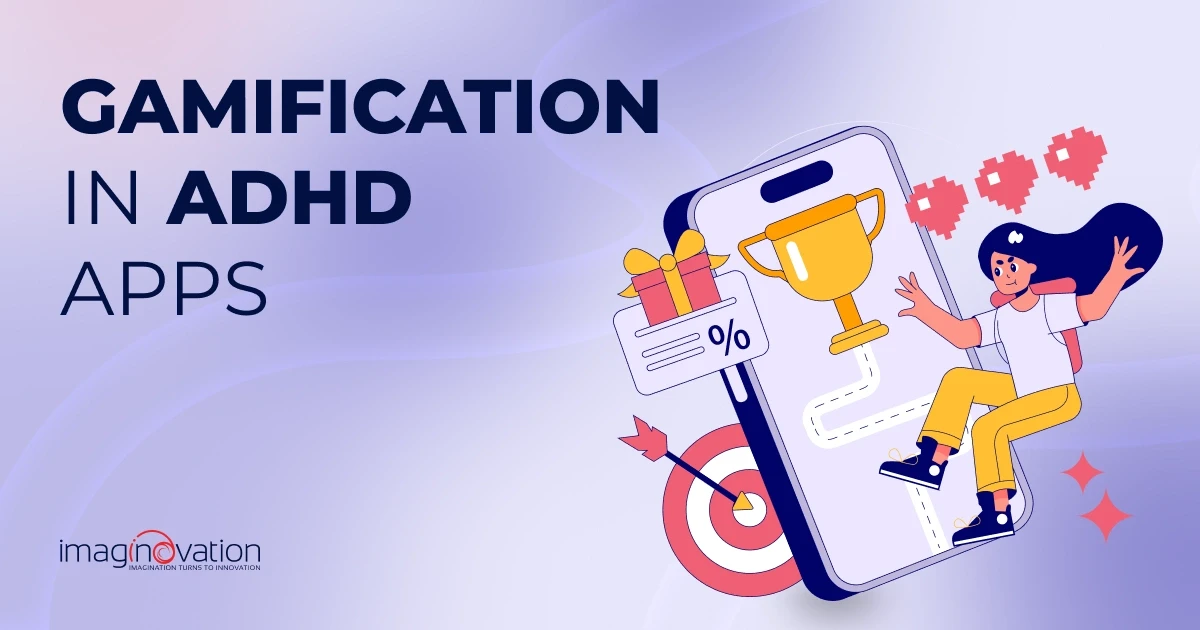The use of Augmented Reality (AR) is fast changing the possibilities within education and training.
AR enhances the learning experience by adding digital elements to the real world. Some educators and trainers are already using this technology to create engaging digital content.
Anything that cannot be achieved with the traditional training pedagogies is done easily with AR technology. From 3D textbooks to human body models, AR can be used to create an exciting learning experience.
When learning is experiential and exciting like this, knowledge retention improves drastically.

Augmented and Virtual Reality in Education Market | Source
Let’s take a look at how different industries can use AR for education and training.
Incredible Ways Different Sectors Can Use AR for Education & Training
Education and training are core to many industries because they present an opportunity to expand the knowledge base.
Today, various industries are exploring AR-based digital solutions for effective education.
Here are the different ways AR is used to enhance education and training:
1. AR and Classroom Education
AR can turn a regular class into an engaging session for both trainers and learners.
It can help teachers better explain the subject, and provide a visual representation of the learning material. Learners focus on practice instead of just theory. Besides, AR-powered classes report fewer distractions and keep the learners engaged.
You can build AR apps for almost every subject, including physics, chemistry, geometry, grammar, zoology, and even programming.
Let’s check a few examples.
QuiverVision – 3D Coloring App is an excellent example of such an app. The app focuses on combining education and entertainment for learner engagement. The trigger images that are provided by the app are printed and colored by the learners. Learners love it when they are able to bring these images to life on their smartphone/tablet screen and play with them.
Arloon Chemistry is another app that has revolutionized the way learners learn to write chemical formulae. They can arrange the molecules displayed in 3D on their screen and learn chemistry in a manner that’s easy to remember.
Elements 4D app by DAQRI helps the learners discover the properties of various elements in an interactive way.
2. AR and the Space Industry
Did you know that NASA’s astronaut candidates have to complete a few years of training here on Earth?
The training includes many activities, workouts, and assignments done in a simulated space environment.
The space industry uses AR to train astronauts and engineers to perform complex tasks that require advanced technical skills and precision.
AR increases the potential of the space sector to decrease crew training requirements.
It eases the learning of the astronauts and engineers to:
- Assemble and build a space capsule faster.
- Maintain a space station.
- Explore the surface of planets by using real-time instructions projected through AR glasses.
- Read visual work instructions with AR glasses, which eliminate the need to turn to paper manuals.
3. AR and Medical Education and Training
AR is one of the up-and-coming digital healthcare technologies and is already revolutionizing how we educate and train our medical staff.
There are many use cases of AR technology in medical education. Some of them include:
- Creating human body models to learn anatomy in detail.
- Providing additional training opportunities with the help of simulations.
- Practicing surgeries on virtual patients.
- AR-enabled training videos to help physicians learn about the latest tools and methods.
For example, the Human Anatomy Atlas, an AR app, helps medical students explore the human body and better understand how it works. The app displays 3D models of the body and allows students to interact with them.
It provides more than 10,000 anatomical models. The app also has a quiz bank to help students check and improve their knowledge.
HoloAnatomy is another app that helps medical students learn about human anatomy using AR simulations.
Touch Surgery is yet another health app that specializes in surgical simulation. It lets the users practice surgery on virtual patients.
4. AR and Military Training
Consistent training is essential to the military. Military training requires a specific environment and location for the soldiers.
However, creating that environment and putting the soldiers in that particular location for training may not always be possible. This is where Augmented Reality plays an important role.
AR is used to create an environment for training soldiers and train them more often without putting their lives in danger.
AR devices emulate a combat environment for the soldiers by projecting digital images of weapons, enemies, and vehicles onto their AR glasses without exposing them to real danger.
It helps save travel expenditures by the military and reduces the need to spend on special equipment because AR can add virtual objects.
For Example, the US Marines tested the Augmented Immersive Team Trainer (AITT) a few years ago. Since then, AITT has been used by the US Marines to reach its training objectives.
AR benefits military training by:
- Providing safer training environments
- Investing in less expensive combat training
- Facilitating more access and engaging mission rehearsals
- Rehearsing with customized terrain diversity
5. AR and Manufacturing Training
The manufacturing sector provides some wonderful examples of how AR is used in training—learning to operate complex machinery in manufacturing always requires lengthy preparation and a lot of theoretical knowledge.
However modern manufacturing workers can complete their tasks using real-time instructions projected on the AR screens.
Besides, companies can relax the stringent eligibility criteria while hiring employees. Manufacturing companies can now hire employees with basic skills and experience and train them on the go using AR instructions.
Siemens, for example, trains its employees on how to weld using AR simulation. When the trainees engage in practicing AR-simulated welding, trainers can check it as displayed on the screen.
A study by Deloitte and the Manufacturing Institute in 2018 showed around 2.4 million manufacturing positions might go unfilled between 2018 and 2028 because of the skills gap in manufacturing.
AR-enabled engaging training is one of the possible solutions to filling this skill gap. With AR, employees can practice without spending too much time on theory.
AR headsets can help by providing step-by-step instructions while a trainee is practicing.
AR-enabled training in manufacturing contributes to:
- Bridging the skills gap
- Decreasing errors
- Maintenance
- Timely Assembly
6. AR and Museum
Audiences everywhere crave interactivity. Augmented Reality enhances the museum’s experience for the audience.
It is done by adding AR content to the museum’s objects – statues, paintings, historical artifacts, documents, and architectural monuments.
Museums create user engagement and increase the visitors’ interest in artistic and cultural heritage. AR content is easily accessed with the help of a smartphone camera.
The botanical garden Jardin Botanique Grand Nancy in France allows visitors to download an AR app. Visitors can view digital animals that fit into the botanical garden scenery with the app’s help during the tour.
Every digital view is accompanied by educational audio content. The app also integrates additional fun games for visitors.
7. AR and Retail
Training is an important activity in the retail industry. Retail companies look for ways to train employees to maximize the use of their time and minimize the mistakes made on the sales floor.
AR technology offers a dynamic alternative to traditional retail training. They offer risk-free, real-life scenarios that sharpen the employee’s skills in retail.
Areas where AR can make improvements are:
- Onboarding
Getting employees quickly acquainted with the company, its procedures, products, and branding, is an essential aspect of retail training. Using AR to do the same can empower the company.
- Customer Service
Companies can use AR training to place employees in scenarios where their customer service skills can be put to the test, all without the risk of real one-to-one customer interaction.
- Product Knowledge
With AR, the new employee can check the company products and familiarize themselves with all of the components and how it works, right on their phone, tablet, or headset.
8. AR and Health & Safety
The practice of health and safety in organizations has always involved manual processes. But with technologies like AR, the focus is no longer on paper-driven methods and compliance. The focus has shifted to innovation.
Health and safety training in the office is not about watching and learning through a video.
For example, when your employees are trained in fire handling, they can take the fire exit walk-around with an AR device. The employee’s screen will inform them of
- Instructions on what’s to be done during an emergency
- Key fire-safety points
- Evacuation points
- Step-by-step instructions on using a fire extinguisher
AR-enabled Gamification allows your employees to set up a health and safety treasure hunt in which they collect digital badges as rewards for completing certain units around the office.
Boeing has enhanced its process to incorporate AR.
With the adoption of AR, the wiring layout in the Boeing aircraft is now directly projected onto the components. This speeds up the procedure and reduces the total number of errors.
AR is set to infiltrate the Learning and Development of most industries. Combining the amazing visuals and endless content, training, and education is transformed like never before.
Benefits of AR for Training and Education
AR’s seamlessness in digitizing objects within the “real world” encourages interactivity and engagement, never experienced before. Incorporating it into education and training has improved learning efficiency. It creates an environment where learners can have a hands-on learning experience.
Here are the benefits of using Augmented Reality in education and training.

1. Engaging Learning Experience
Technologies like AR are meant to raise engagement levels in learners. It is because it allows instructional designers and game designers to combine fun with e-learning content delivery.
Not only is the AR content visually attractive and fun to work with, but it also appeals to learners because of the risk-free element of learning. It is risk-free because learners can make the same mistakes as many times as they need to learn how to act the right way.
Practice by doing is one of the most effective methods of learning. AR helps make training interactive and allows learners to focus more on practice instead of just theory.
So, rather than just reading from books or listening to lectures, AR-enabled content allows learners to practice with headsets and goggles’ help. This increases user engagement and improves the learning experience.
2. Effectiveness of Learning Materials
Companies can develop interesting learning solutions with AR. Pointing the phone camera at a specific text of the training manual may lead to additional materials or resources popping up on the users’ screen. It is useful to train employees about various products, services, and solutions of the company.
AR training is more effective than traditional methods. AR learners have a better recall rate as compared to learners from conventional methods.
3. Affordable Learning
Educational material is generally quite expensive. Not all educational institutions can afford to build, purchase, and maintain them. But with AR-enabled learning, learners only need mobile devices like smartphones or tablets, an internet connection, and AR apps. This makes AR-enabled education accessible.
AR also helps save costs on employee training because all one needs are mobile devices, AR headsets, WiFi, and apps instead of traditional seminars and classes.
4. A wide range of fields
It is interesting to know that the use of AR is not limited to a specific subject, age, or educational level.
AR is used for training – both pre-school and higher education and even for corporate training. It is applied in various fields, from military and retail to medical industries and space.
5. Safe training
Many industries need to train their employees to handle critical processes and situations.
For example, employees working in power plants and manufacturing units must understand how to operate machines properly on the site.
But unless they get a good grasp of things, they cannot be allowed to take over work in real. AR can simulate potentially dangerous situations like engine failure, letting workers safely practice their actions in such cases.
Trainees can practice repairing high-voltage equipment or identifying and handling potential emergencies. That means that AR lets students and trainees prepare for critical situations without endangering themselves or anyone else by simulating these situations.
How to Get Started?
Diving into something new, especially a new technology for your business, may seem intimidating at first. But if you take small decisive steps, it is easy.
Here are a few things to consider while creating an AR app for your business.
- Define the objective and target audience for your app. Remember, depending on your user's age and the general purpose of the app, the functionality will differ.
- Polish the idea through market research, competitor analysis, and viability testing. It’ll help you understand the real potential of your app.
- Explore the market of existing SDKs and platforms for AR development. Select the one that best fits your business idea, objective, and budget. For example, platforms like Vuforia, Wikitude, ARCore, and ARKit are available, or can opt for easier solutions – with tools like Blippar or Aurasma.
- Build a Proof of Concept (POC) to test the capabilities of the chosen tech stack.
- Create a Minimum Viable Product (MVP) first. It will be the basic app version, just to test the core functionality of your app.
- Test the app and iterate toward its success. Keep in mind that you will need to update the app regularly with new AR content.
Build An Incredible AR App for Education & Training with Imaginovation
Newer AR business opportunities are becoming available in every field. They are set to transform the way educational content is produced and delivered. One cannot overlook the benefits of AR for education and training.
So, don’t be the last one to reap its benefits.
If you want to build an AR app for education and training in your business, set your imagination free, and envision how AR will empower your business. We will help you develop your idea into Reality. We will help you create an AR app for your business.
We are an award-winning web and mobile app development company with vast experience in crafting remarkable digital success stories for diverse companies.
Ready to build an app, but not sure where to start?
We've got you covered. Click the button below to get started.





